Organizational Change and Leadership Management Report
VerifiedAdded on 2020/01/15
|16
|4085
|144
Report
AI Summary
This report delves into the multifaceted aspects of organizational change and the pivotal role of leadership in driving successful transformations. It begins by exploring the importance of leadership in implementing change, emphasizing the need for leaders to motivate employees and guide them through new processes. The report then compares Theory O and Theory E, providing a detailed analysis of their goals, leadership approaches, and focus, ultimately advocating for the adoption of Theory O for its emphasis on employee commitment and cultural transformation. Further, the report identifies and explains key barriers to change, including complacency, lack of vision, and employee resistance, while also examining Kotter's eight-step change model to facilitate successful change implementation. The report concludes by addressing the question of employee resistance, arguing that while it is a significant factor, it is not the sole reason for change failures, and also discusses other factors like constant changes affecting productivity. The report is a comprehensive guide to understanding and managing organizational change effectively.
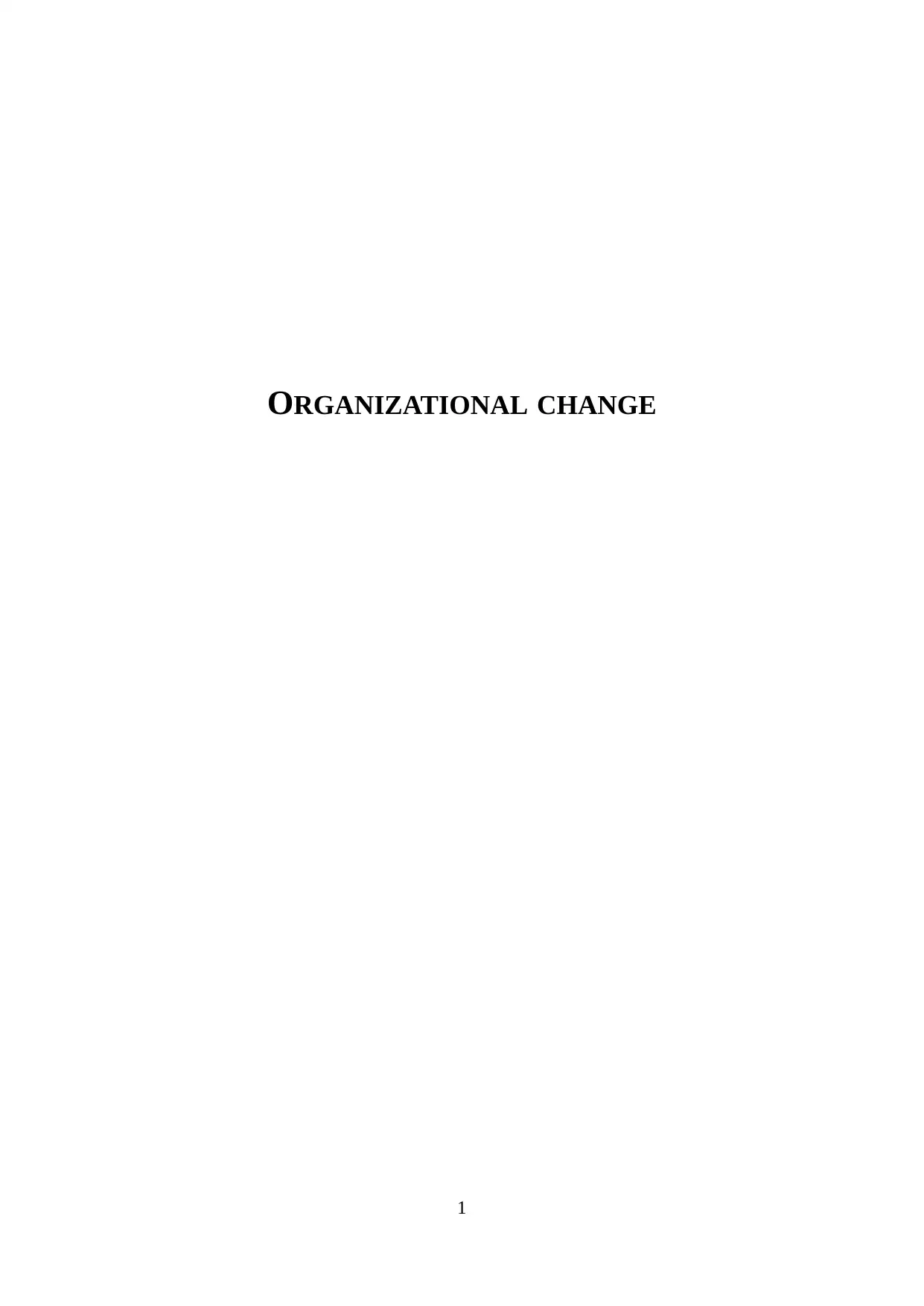
ORGANIZATIONAL CHANGE
1
1
Paraphrase This Document
Need a fresh take? Get an instant paraphrase of this document with our AI Paraphraser

Table of Contents
ARTICLE 1..........................................................................................................................................3
Role of leadership in change management..................................................................................3
ARTICLE 2..........................................................................................................................................5
Compare theories of O and E and justify which theory is more suitable for managing people in
the organization...........................................................................................................................5
ARTICLE 3..........................................................................................................................................7
Barriers to change.......................................................................................................................7
Portfolio 4.............................................................................................................................................9
Is employee resistance to change, the main reason for the failure of many change efforts in
organizations? Discuss the statement with reference to Burnes.................................................9
Portfolio 5...........................................................................................................................................11
In your view is change always good for the organization.........................................................11
Portfolio 6...........................................................................................................................................13
How to handle change to thrive as an organization..................................................................13
REFERENCES...................................................................................................................................15
2
ARTICLE 1..........................................................................................................................................3
Role of leadership in change management..................................................................................3
ARTICLE 2..........................................................................................................................................5
Compare theories of O and E and justify which theory is more suitable for managing people in
the organization...........................................................................................................................5
ARTICLE 3..........................................................................................................................................7
Barriers to change.......................................................................................................................7
Portfolio 4.............................................................................................................................................9
Is employee resistance to change, the main reason for the failure of many change efforts in
organizations? Discuss the statement with reference to Burnes.................................................9
Portfolio 5...........................................................................................................................................11
In your view is change always good for the organization.........................................................11
Portfolio 6...........................................................................................................................................13
How to handle change to thrive as an organization..................................................................13
REFERENCES...................................................................................................................................15
2
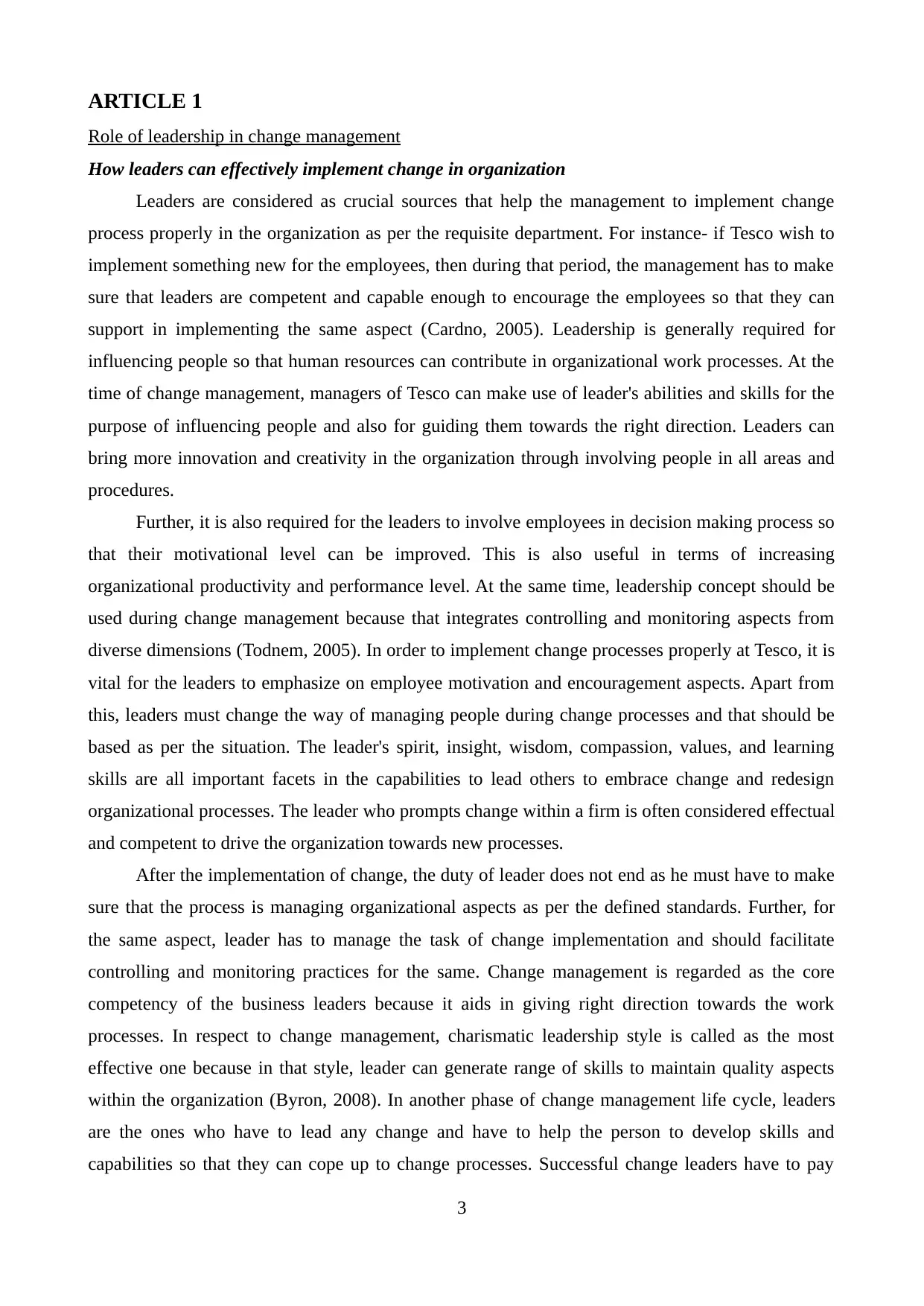
ARTICLE 1
Role of leadership in change management
How leaders can effectively implement change in organization
Leaders are considered as crucial sources that help the management to implement change
process properly in the organization as per the requisite department. For instance- if Tesco wish to
implement something new for the employees, then during that period, the management has to make
sure that leaders are competent and capable enough to encourage the employees so that they can
support in implementing the same aspect (Cardno, 2005). Leadership is generally required for
influencing people so that human resources can contribute in organizational work processes. At the
time of change management, managers of Tesco can make use of leader's abilities and skills for the
purpose of influencing people and also for guiding them towards the right direction. Leaders can
bring more innovation and creativity in the organization through involving people in all areas and
procedures.
Further, it is also required for the leaders to involve employees in decision making process so
that their motivational level can be improved. This is also useful in terms of increasing
organizational productivity and performance level. At the same time, leadership concept should be
used during change management because that integrates controlling and monitoring aspects from
diverse dimensions (Todnem, 2005). In order to implement change processes properly at Tesco, it is
vital for the leaders to emphasize on employee motivation and encouragement aspects. Apart from
this, leaders must change the way of managing people during change processes and that should be
based as per the situation. The leader's spirit, insight, wisdom, compassion, values, and learning
skills are all important facets in the capabilities to lead others to embrace change and redesign
organizational processes. The leader who prompts change within a firm is often considered effectual
and competent to drive the organization towards new processes.
After the implementation of change, the duty of leader does not end as he must have to make
sure that the process is managing organizational aspects as per the defined standards. Further, for
the same aspect, leader has to manage the task of change implementation and should facilitate
controlling and monitoring practices for the same. Change management is regarded as the core
competency of the business leaders because it aids in giving right direction towards the work
processes. In respect to change management, charismatic leadership style is called as the most
effective one because in that style, leader can generate range of skills to maintain quality aspects
within the organization (Byron, 2008). In another phase of change management life cycle, leaders
are the ones who have to lead any change and have to help the person to develop skills and
capabilities so that they can cope up to change processes. Successful change leaders have to pay
3
Role of leadership in change management
How leaders can effectively implement change in organization
Leaders are considered as crucial sources that help the management to implement change
process properly in the organization as per the requisite department. For instance- if Tesco wish to
implement something new for the employees, then during that period, the management has to make
sure that leaders are competent and capable enough to encourage the employees so that they can
support in implementing the same aspect (Cardno, 2005). Leadership is generally required for
influencing people so that human resources can contribute in organizational work processes. At the
time of change management, managers of Tesco can make use of leader's abilities and skills for the
purpose of influencing people and also for guiding them towards the right direction. Leaders can
bring more innovation and creativity in the organization through involving people in all areas and
procedures.
Further, it is also required for the leaders to involve employees in decision making process so
that their motivational level can be improved. This is also useful in terms of increasing
organizational productivity and performance level. At the same time, leadership concept should be
used during change management because that integrates controlling and monitoring aspects from
diverse dimensions (Todnem, 2005). In order to implement change processes properly at Tesco, it is
vital for the leaders to emphasize on employee motivation and encouragement aspects. Apart from
this, leaders must change the way of managing people during change processes and that should be
based as per the situation. The leader's spirit, insight, wisdom, compassion, values, and learning
skills are all important facets in the capabilities to lead others to embrace change and redesign
organizational processes. The leader who prompts change within a firm is often considered effectual
and competent to drive the organization towards new processes.
After the implementation of change, the duty of leader does not end as he must have to make
sure that the process is managing organizational aspects as per the defined standards. Further, for
the same aspect, leader has to manage the task of change implementation and should facilitate
controlling and monitoring practices for the same. Change management is regarded as the core
competency of the business leaders because it aids in giving right direction towards the work
processes. In respect to change management, charismatic leadership style is called as the most
effective one because in that style, leader can generate range of skills to maintain quality aspects
within the organization (Byron, 2008). In another phase of change management life cycle, leaders
are the ones who have to lead any change and have to help the person to develop skills and
capabilities so that they can cope up to change processes. Successful change leaders have to pay
3
⊘ This is a preview!⊘
Do you want full access?
Subscribe today to unlock all pages.

Trusted by 1+ million students worldwide
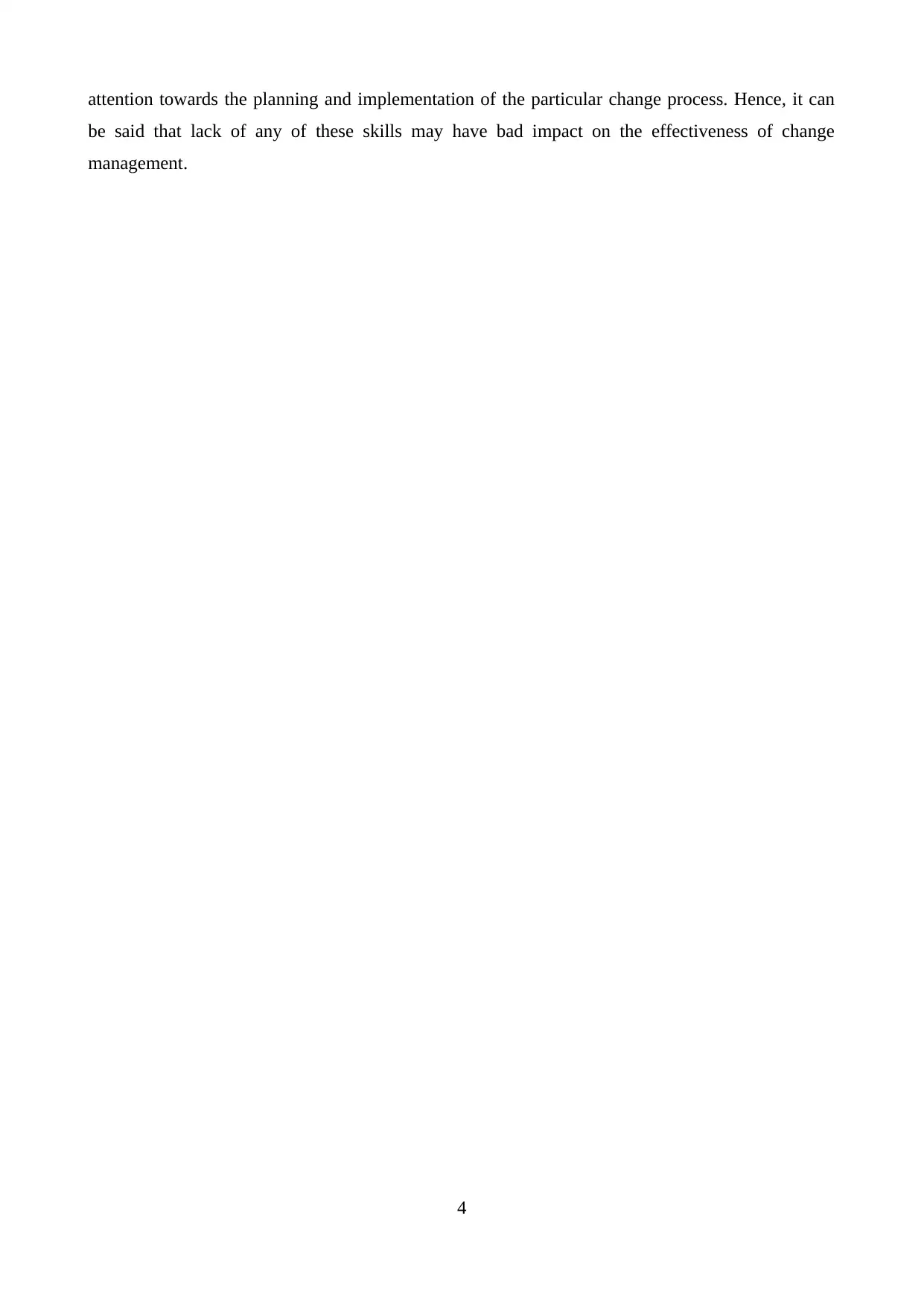
attention towards the planning and implementation of the particular change process. Hence, it can
be said that lack of any of these skills may have bad impact on the effectiveness of change
management.
4
be said that lack of any of these skills may have bad impact on the effectiveness of change
management.
4
Paraphrase This Document
Need a fresh take? Get an instant paraphrase of this document with our AI Paraphraser
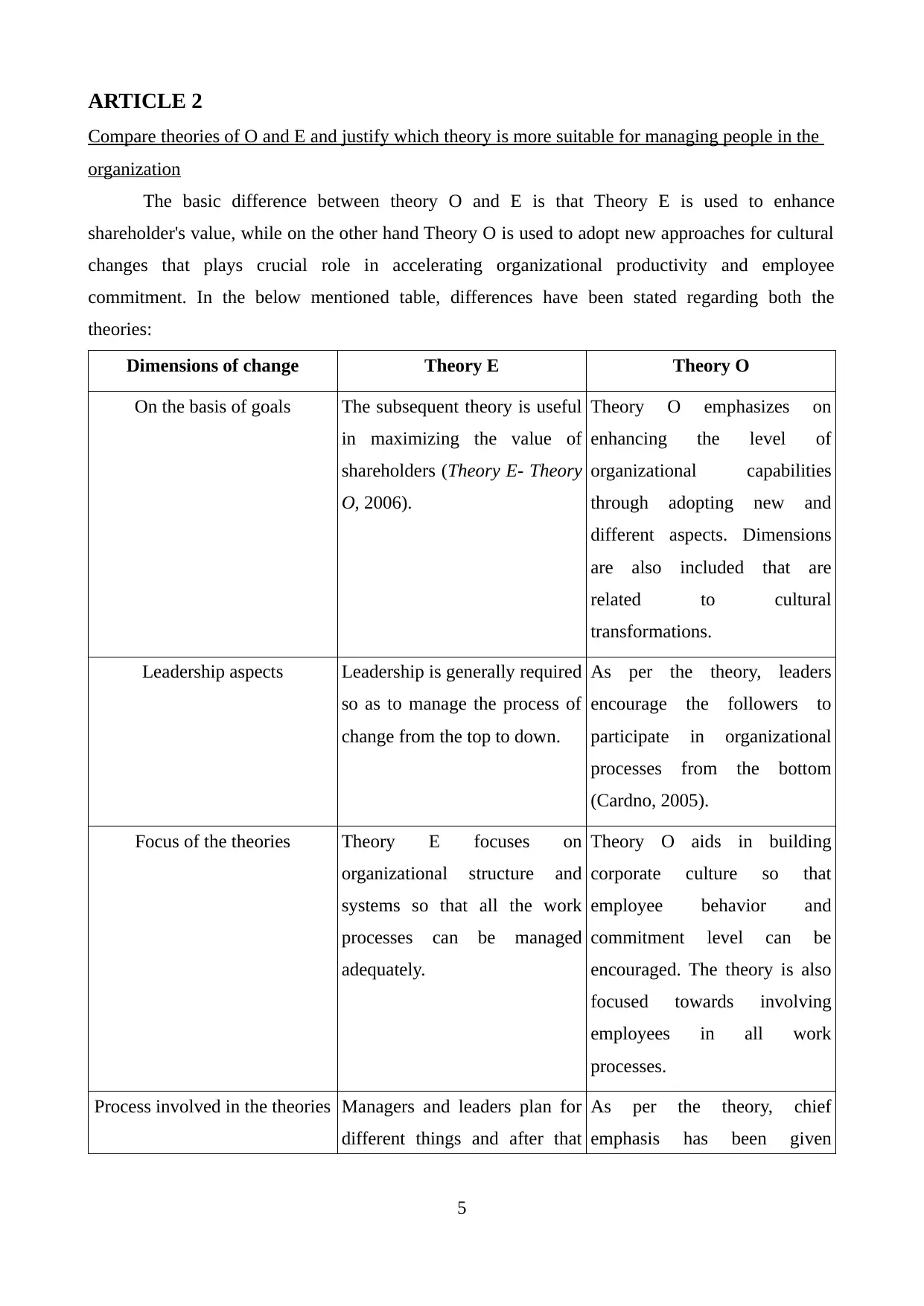
ARTICLE 2
Compare theories of O and E and justify which theory is more suitable for managing people in the
organization
The basic difference between theory O and E is that Theory E is used to enhance
shareholder's value, while on the other hand Theory O is used to adopt new approaches for cultural
changes that plays crucial role in accelerating organizational productivity and employee
commitment. In the below mentioned table, differences have been stated regarding both the
theories:
Dimensions of change Theory E Theory O
On the basis of goals The subsequent theory is useful
in maximizing the value of
shareholders (Theory E- Theory
O, 2006).
Theory O emphasizes on
enhancing the level of
organizational capabilities
through adopting new and
different aspects. Dimensions
are also included that are
related to cultural
transformations.
Leadership aspects Leadership is generally required
so as to manage the process of
change from the top to down.
As per the theory, leaders
encourage the followers to
participate in organizational
processes from the bottom
(Cardno, 2005).
Focus of the theories Theory E focuses on
organizational structure and
systems so that all the work
processes can be managed
adequately.
Theory O aids in building
corporate culture so that
employee behavior and
commitment level can be
encouraged. The theory is also
focused towards involving
employees in all work
processes.
Process involved in the theories Managers and leaders plan for
different things and after that
As per the theory, chief
emphasis has been given
5
Compare theories of O and E and justify which theory is more suitable for managing people in the
organization
The basic difference between theory O and E is that Theory E is used to enhance
shareholder's value, while on the other hand Theory O is used to adopt new approaches for cultural
changes that plays crucial role in accelerating organizational productivity and employee
commitment. In the below mentioned table, differences have been stated regarding both the
theories:
Dimensions of change Theory E Theory O
On the basis of goals The subsequent theory is useful
in maximizing the value of
shareholders (Theory E- Theory
O, 2006).
Theory O emphasizes on
enhancing the level of
organizational capabilities
through adopting new and
different aspects. Dimensions
are also included that are
related to cultural
transformations.
Leadership aspects Leadership is generally required
so as to manage the process of
change from the top to down.
As per the theory, leaders
encourage the followers to
participate in organizational
processes from the bottom
(Cardno, 2005).
Focus of the theories Theory E focuses on
organizational structure and
systems so that all the work
processes can be managed
adequately.
Theory O aids in building
corporate culture so that
employee behavior and
commitment level can be
encouraged. The theory is also
focused towards involving
employees in all work
processes.
Process involved in the theories Managers and leaders plan for
different things and after that
As per the theory, chief
emphasis has been given
5
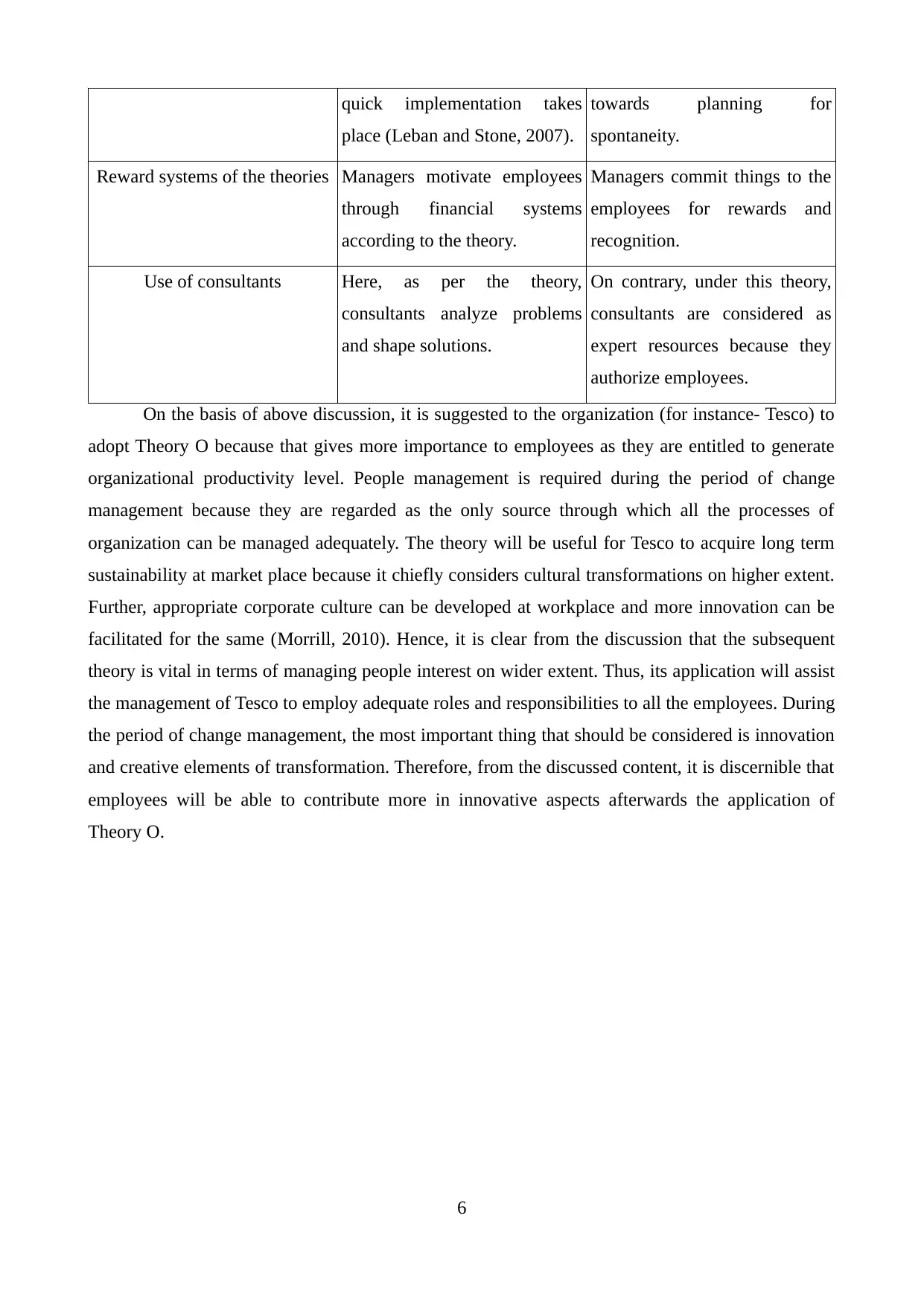
quick implementation takes
place (Leban and Stone, 2007).
towards planning for
spontaneity.
Reward systems of the theories Managers motivate employees
through financial systems
according to the theory.
Managers commit things to the
employees for rewards and
recognition.
Use of consultants Here, as per the theory,
consultants analyze problems
and shape solutions.
On contrary, under this theory,
consultants are considered as
expert resources because they
authorize employees.
On the basis of above discussion, it is suggested to the organization (for instance- Tesco) to
adopt Theory O because that gives more importance to employees as they are entitled to generate
organizational productivity level. People management is required during the period of change
management because they are regarded as the only source through which all the processes of
organization can be managed adequately. The theory will be useful for Tesco to acquire long term
sustainability at market place because it chiefly considers cultural transformations on higher extent.
Further, appropriate corporate culture can be developed at workplace and more innovation can be
facilitated for the same (Morrill, 2010). Hence, it is clear from the discussion that the subsequent
theory is vital in terms of managing people interest on wider extent. Thus, its application will assist
the management of Tesco to employ adequate roles and responsibilities to all the employees. During
the period of change management, the most important thing that should be considered is innovation
and creative elements of transformation. Therefore, from the discussed content, it is discernible that
employees will be able to contribute more in innovative aspects afterwards the application of
Theory O.
6
place (Leban and Stone, 2007).
towards planning for
spontaneity.
Reward systems of the theories Managers motivate employees
through financial systems
according to the theory.
Managers commit things to the
employees for rewards and
recognition.
Use of consultants Here, as per the theory,
consultants analyze problems
and shape solutions.
On contrary, under this theory,
consultants are considered as
expert resources because they
authorize employees.
On the basis of above discussion, it is suggested to the organization (for instance- Tesco) to
adopt Theory O because that gives more importance to employees as they are entitled to generate
organizational productivity level. People management is required during the period of change
management because they are regarded as the only source through which all the processes of
organization can be managed adequately. The theory will be useful for Tesco to acquire long term
sustainability at market place because it chiefly considers cultural transformations on higher extent.
Further, appropriate corporate culture can be developed at workplace and more innovation can be
facilitated for the same (Morrill, 2010). Hence, it is clear from the discussion that the subsequent
theory is vital in terms of managing people interest on wider extent. Thus, its application will assist
the management of Tesco to employ adequate roles and responsibilities to all the employees. During
the period of change management, the most important thing that should be considered is innovation
and creative elements of transformation. Therefore, from the discussed content, it is discernible that
employees will be able to contribute more in innovative aspects afterwards the application of
Theory O.
6
⊘ This is a preview!⊘
Do you want full access?
Subscribe today to unlock all pages.

Trusted by 1+ million students worldwide

ARTICLE 3
Barriers to change
Explain 4 major dimensions of Kotter's book heart of change to enable more successful change
in the organization
It is an apparent fact that when change appears in the organization, people resist
implementing it because of several reasons. Thus, the same issue could also arise with Tesco by the
time the business entity executes the change. Several barriers to change are discussed in the below
section:
Too much complacency
Failing to create a sufficiently powerful guiding coalition
Underestimating the power of vision (Todnem, 2005)
Fail to accomplish short term goals
Employee resistance
Lack of support from the personnel members
Complexity of change process
The Heart of Change
People change their day-to-day processes because they are influenced from something which
drives them to move towards change processes. Usually, this happens in larger organizations like
Tesco where the business entity has to deal with cultural transformations, new technologies and
globalization. The major dimensions of John Kotter's change model are mentioned in the below
section: Create a sense of urgency: At the initial stage, it is vital to make initiative for change
management so that new and innovative things can be adopted (The heart of change, 2002). Pull together to guide a team: Powerful team is required to be developed so that the
purpose of change management can be fulfilled. This is such stage where people have to
support each other for the purpose of fulfilling the purpose of change. Create simple, clear and uplifting visions: Strategies are required to be formulated. It
should be integrated with simple and clear vision so that the aim of change process can be
fulfilled. Communicate the vision through proper messages: It is essential for the manager of Tesco
to communicate the vision and objective of change process. It is made through simple and
multiple channels so that people can at least begin to cope with the respective change. Empower people: Authorities and duties should be delegated properly so that organizational
members can reach towards the defined targets. This is also vital in terms of reducing
7
Barriers to change
Explain 4 major dimensions of Kotter's book heart of change to enable more successful change
in the organization
It is an apparent fact that when change appears in the organization, people resist
implementing it because of several reasons. Thus, the same issue could also arise with Tesco by the
time the business entity executes the change. Several barriers to change are discussed in the below
section:
Too much complacency
Failing to create a sufficiently powerful guiding coalition
Underestimating the power of vision (Todnem, 2005)
Fail to accomplish short term goals
Employee resistance
Lack of support from the personnel members
Complexity of change process
The Heart of Change
People change their day-to-day processes because they are influenced from something which
drives them to move towards change processes. Usually, this happens in larger organizations like
Tesco where the business entity has to deal with cultural transformations, new technologies and
globalization. The major dimensions of John Kotter's change model are mentioned in the below
section: Create a sense of urgency: At the initial stage, it is vital to make initiative for change
management so that new and innovative things can be adopted (The heart of change, 2002). Pull together to guide a team: Powerful team is required to be developed so that the
purpose of change management can be fulfilled. This is such stage where people have to
support each other for the purpose of fulfilling the purpose of change. Create simple, clear and uplifting visions: Strategies are required to be formulated. It
should be integrated with simple and clear vision so that the aim of change process can be
fulfilled. Communicate the vision through proper messages: It is essential for the manager of Tesco
to communicate the vision and objective of change process. It is made through simple and
multiple channels so that people can at least begin to cope with the respective change. Empower people: Authorities and duties should be delegated properly so that organizational
members can reach towards the defined targets. This is also vital in terms of reducing
7
Paraphrase This Document
Need a fresh take? Get an instant paraphrase of this document with our AI Paraphraser

obstacles concerned with change process. Create short terms wins: Short term aims and objectives should be developed so that
implemented efforts on change can bring optimum results to the management of Tesco.
People should focus on feedback so that improvements can be made accordingly. Hence,
integration is required in each and every step of change management (The 8-Step Process
for Leading Change, 2012). Maintain momentum: The process of change management should be maintained for longer
period and leaders must facilitate controlling actions on the entire process.
Make change stick: Changes should be executed properly in all the areas so that a new
culture can be developed at workplace. If change brings positive results, then it should be
continued for longer period.
Thus, from the discussion, it is clear that theoretical framework is better because that assists
the management to execute the entire process in prominent manner. When change brings optimistic
outcomes, it indicates that the process has successfully worked in the respective area.
8
implemented efforts on change can bring optimum results to the management of Tesco.
People should focus on feedback so that improvements can be made accordingly. Hence,
integration is required in each and every step of change management (The 8-Step Process
for Leading Change, 2012). Maintain momentum: The process of change management should be maintained for longer
period and leaders must facilitate controlling actions on the entire process.
Make change stick: Changes should be executed properly in all the areas so that a new
culture can be developed at workplace. If change brings positive results, then it should be
continued for longer period.
Thus, from the discussion, it is clear that theoretical framework is better because that assists
the management to execute the entire process in prominent manner. When change brings optimistic
outcomes, it indicates that the process has successfully worked in the respective area.
8
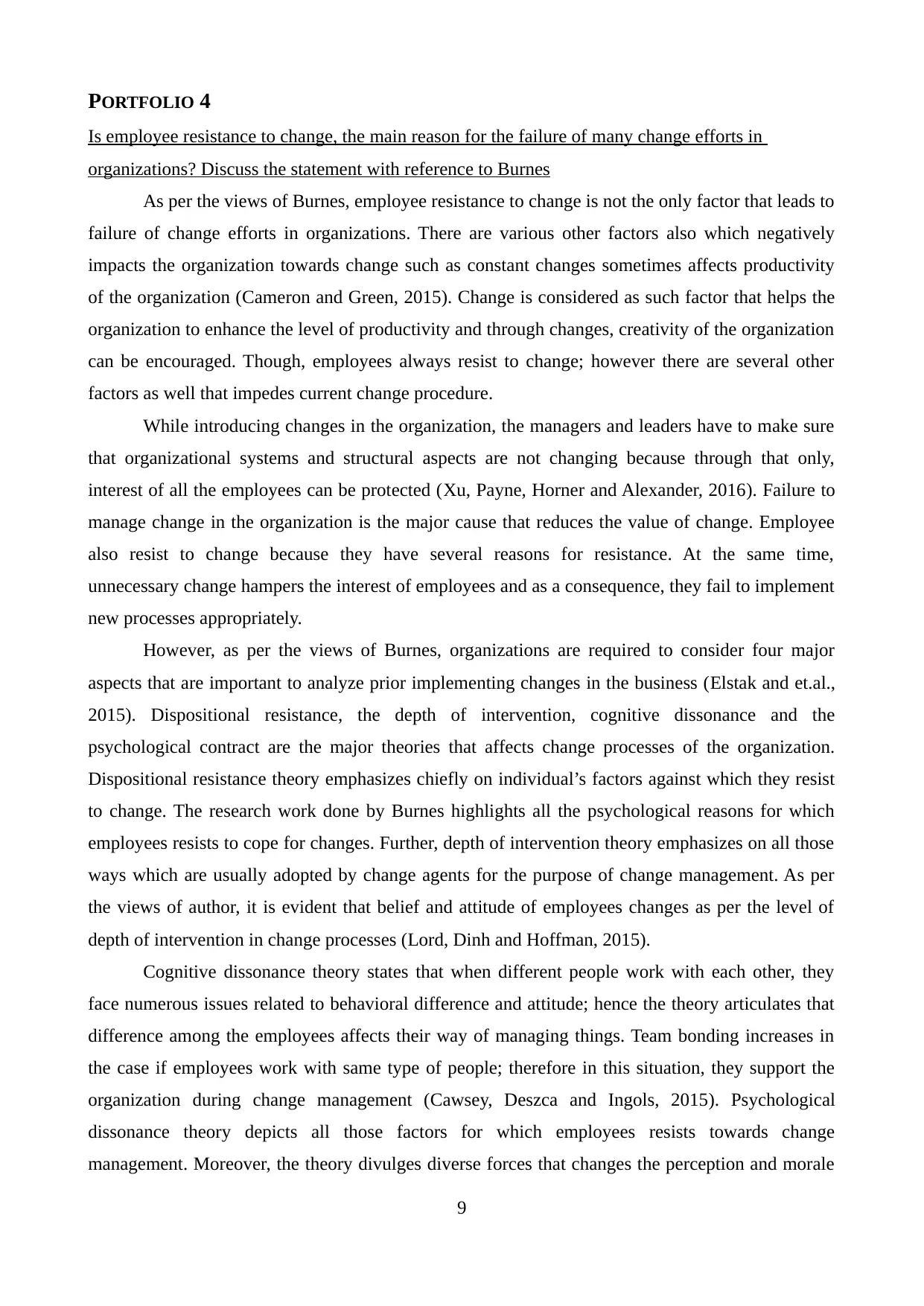
PORTFOLIO 4
Is employee resistance to change, the main reason for the failure of many change efforts in
organizations? Discuss the statement with reference to Burnes
As per the views of Burnes, employee resistance to change is not the only factor that leads to
failure of change efforts in organizations. There are various other factors also which negatively
impacts the organization towards change such as constant changes sometimes affects productivity
of the organization (Cameron and Green, 2015). Change is considered as such factor that helps the
organization to enhance the level of productivity and through changes, creativity of the organization
can be encouraged. Though, employees always resist to change; however there are several other
factors as well that impedes current change procedure.
While introducing changes in the organization, the managers and leaders have to make sure
that organizational systems and structural aspects are not changing because through that only,
interest of all the employees can be protected (Xu, Payne, Horner and Alexander, 2016). Failure to
manage change in the organization is the major cause that reduces the value of change. Employee
also resist to change because they have several reasons for resistance. At the same time,
unnecessary change hampers the interest of employees and as a consequence, they fail to implement
new processes appropriately.
However, as per the views of Burnes, organizations are required to consider four major
aspects that are important to analyze prior implementing changes in the business (Elstak and et.al.,
2015). Dispositional resistance, the depth of intervention, cognitive dissonance and the
psychological contract are the major theories that affects change processes of the organization.
Dispositional resistance theory emphasizes chiefly on individual’s factors against which they resist
to change. The research work done by Burnes highlights all the psychological reasons for which
employees resists to cope for changes. Further, depth of intervention theory emphasizes on all those
ways which are usually adopted by change agents for the purpose of change management. As per
the views of author, it is evident that belief and attitude of employees changes as per the level of
depth of intervention in change processes (Lord, Dinh and Hoffman, 2015).
Cognitive dissonance theory states that when different people work with each other, they
face numerous issues related to behavioral difference and attitude; hence the theory articulates that
difference among the employees affects their way of managing things. Team bonding increases in
the case if employees work with same type of people; therefore in this situation, they support the
organization during change management (Cawsey, Deszca and Ingols, 2015). Psychological
dissonance theory depicts all those factors for which employees resists towards change
management. Moreover, the theory divulges diverse forces that changes the perception and morale
9
Is employee resistance to change, the main reason for the failure of many change efforts in
organizations? Discuss the statement with reference to Burnes
As per the views of Burnes, employee resistance to change is not the only factor that leads to
failure of change efforts in organizations. There are various other factors also which negatively
impacts the organization towards change such as constant changes sometimes affects productivity
of the organization (Cameron and Green, 2015). Change is considered as such factor that helps the
organization to enhance the level of productivity and through changes, creativity of the organization
can be encouraged. Though, employees always resist to change; however there are several other
factors as well that impedes current change procedure.
While introducing changes in the organization, the managers and leaders have to make sure
that organizational systems and structural aspects are not changing because through that only,
interest of all the employees can be protected (Xu, Payne, Horner and Alexander, 2016). Failure to
manage change in the organization is the major cause that reduces the value of change. Employee
also resist to change because they have several reasons for resistance. At the same time,
unnecessary change hampers the interest of employees and as a consequence, they fail to implement
new processes appropriately.
However, as per the views of Burnes, organizations are required to consider four major
aspects that are important to analyze prior implementing changes in the business (Elstak and et.al.,
2015). Dispositional resistance, the depth of intervention, cognitive dissonance and the
psychological contract are the major theories that affects change processes of the organization.
Dispositional resistance theory emphasizes chiefly on individual’s factors against which they resist
to change. The research work done by Burnes highlights all the psychological reasons for which
employees resists to cope for changes. Further, depth of intervention theory emphasizes on all those
ways which are usually adopted by change agents for the purpose of change management. As per
the views of author, it is evident that belief and attitude of employees changes as per the level of
depth of intervention in change processes (Lord, Dinh and Hoffman, 2015).
Cognitive dissonance theory states that when different people work with each other, they
face numerous issues related to behavioral difference and attitude; hence the theory articulates that
difference among the employees affects their way of managing things. Team bonding increases in
the case if employees work with same type of people; therefore in this situation, they support the
organization during change management (Cawsey, Deszca and Ingols, 2015). Psychological
dissonance theory depicts all those factors for which employees resists towards change
management. Moreover, the theory divulges diverse forces that changes the perception and morale
9
⊘ This is a preview!⊘
Do you want full access?
Subscribe today to unlock all pages.

Trusted by 1+ million students worldwide
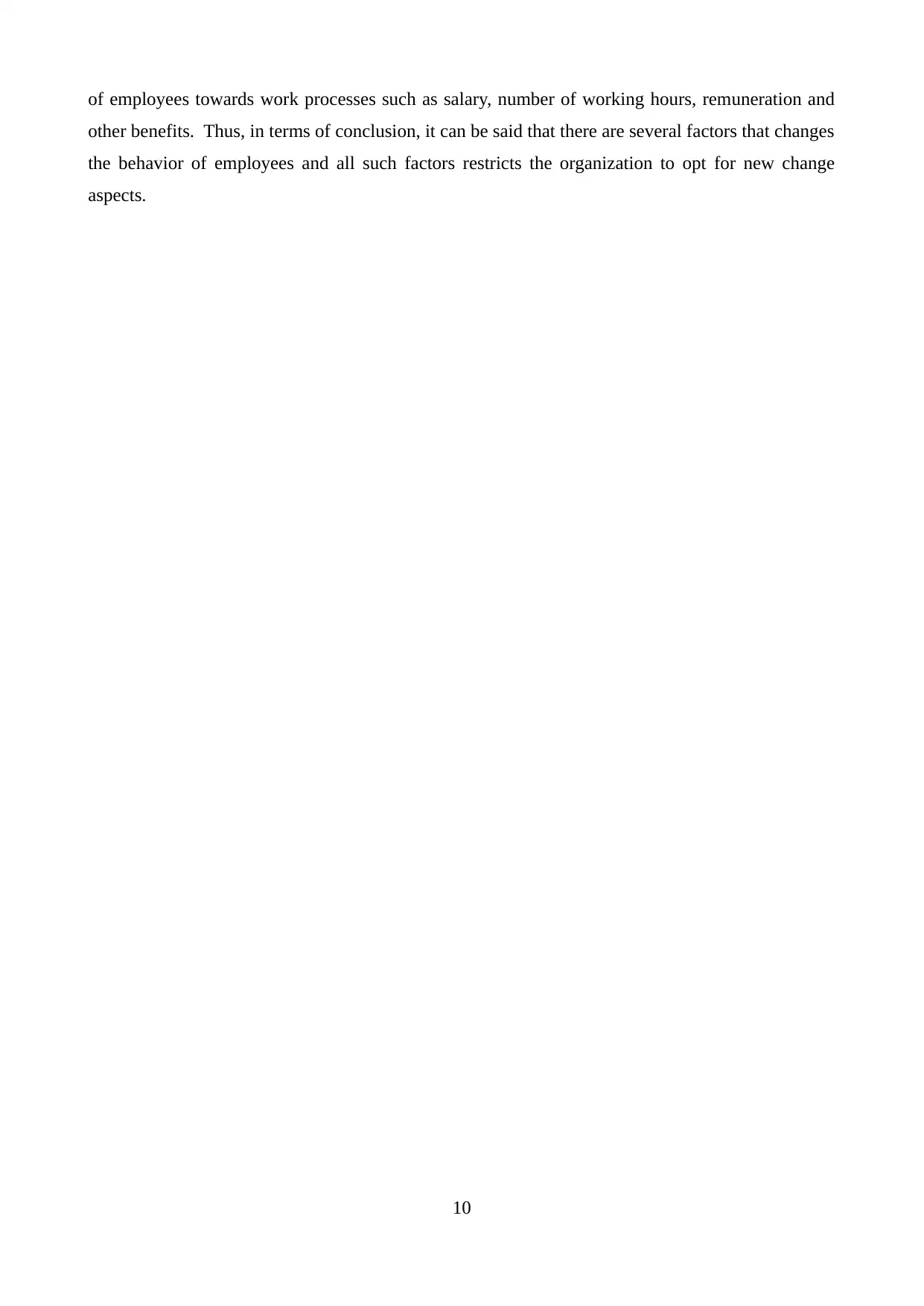
of employees towards work processes such as salary, number of working hours, remuneration and
other benefits. Thus, in terms of conclusion, it can be said that there are several factors that changes
the behavior of employees and all such factors restricts the organization to opt for new change
aspects.
10
other benefits. Thus, in terms of conclusion, it can be said that there are several factors that changes
the behavior of employees and all such factors restricts the organization to opt for new change
aspects.
10
Paraphrase This Document
Need a fresh take? Get an instant paraphrase of this document with our AI Paraphraser
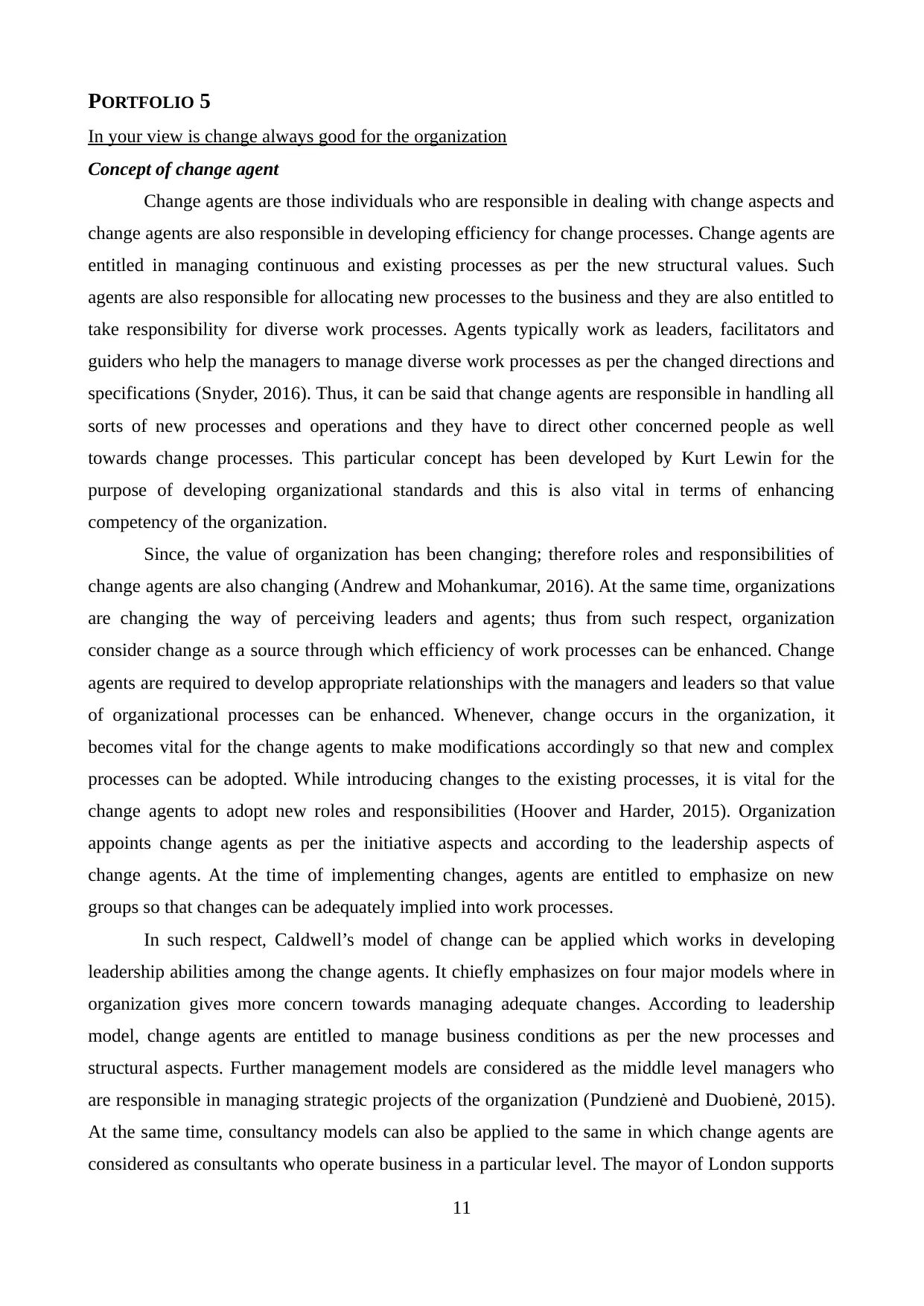
PORTFOLIO 5
In your view is change always good for the organization
Concept of change agent
Change agents are those individuals who are responsible in dealing with change aspects and
change agents are also responsible in developing efficiency for change processes. Change agents are
entitled in managing continuous and existing processes as per the new structural values. Such
agents are also responsible for allocating new processes to the business and they are also entitled to
take responsibility for diverse work processes. Agents typically work as leaders, facilitators and
guiders who help the managers to manage diverse work processes as per the changed directions and
specifications (Snyder, 2016). Thus, it can be said that change agents are responsible in handling all
sorts of new processes and operations and they have to direct other concerned people as well
towards change processes. This particular concept has been developed by Kurt Lewin for the
purpose of developing organizational standards and this is also vital in terms of enhancing
competency of the organization.
Since, the value of organization has been changing; therefore roles and responsibilities of
change agents are also changing (Andrew and Mohankumar, 2016). At the same time, organizations
are changing the way of perceiving leaders and agents; thus from such respect, organization
consider change as a source through which efficiency of work processes can be enhanced. Change
agents are required to develop appropriate relationships with the managers and leaders so that value
of organizational processes can be enhanced. Whenever, change occurs in the organization, it
becomes vital for the change agents to make modifications accordingly so that new and complex
processes can be adopted. While introducing changes to the existing processes, it is vital for the
change agents to adopt new roles and responsibilities (Hoover and Harder, 2015). Organization
appoints change agents as per the initiative aspects and according to the leadership aspects of
change agents. At the time of implementing changes, agents are entitled to emphasize on new
groups so that changes can be adequately implied into work processes.
In such respect, Caldwell’s model of change can be applied which works in developing
leadership abilities among the change agents. It chiefly emphasizes on four major models where in
organization gives more concern towards managing adequate changes. According to leadership
model, change agents are entitled to manage business conditions as per the new processes and
structural aspects. Further management models are considered as the middle level managers who
are responsible in managing strategic projects of the organization (Pundzienė and Duobienė, 2015).
At the same time, consultancy models can also be applied to the same in which change agents are
considered as consultants who operate business in a particular level. The mayor of London supports
11
In your view is change always good for the organization
Concept of change agent
Change agents are those individuals who are responsible in dealing with change aspects and
change agents are also responsible in developing efficiency for change processes. Change agents are
entitled in managing continuous and existing processes as per the new structural values. Such
agents are also responsible for allocating new processes to the business and they are also entitled to
take responsibility for diverse work processes. Agents typically work as leaders, facilitators and
guiders who help the managers to manage diverse work processes as per the changed directions and
specifications (Snyder, 2016). Thus, it can be said that change agents are responsible in handling all
sorts of new processes and operations and they have to direct other concerned people as well
towards change processes. This particular concept has been developed by Kurt Lewin for the
purpose of developing organizational standards and this is also vital in terms of enhancing
competency of the organization.
Since, the value of organization has been changing; therefore roles and responsibilities of
change agents are also changing (Andrew and Mohankumar, 2016). At the same time, organizations
are changing the way of perceiving leaders and agents; thus from such respect, organization
consider change as a source through which efficiency of work processes can be enhanced. Change
agents are required to develop appropriate relationships with the managers and leaders so that value
of organizational processes can be enhanced. Whenever, change occurs in the organization, it
becomes vital for the change agents to make modifications accordingly so that new and complex
processes can be adopted. While introducing changes to the existing processes, it is vital for the
change agents to adopt new roles and responsibilities (Hoover and Harder, 2015). Organization
appoints change agents as per the initiative aspects and according to the leadership aspects of
change agents. At the time of implementing changes, agents are entitled to emphasize on new
groups so that changes can be adequately implied into work processes.
In such respect, Caldwell’s model of change can be applied which works in developing
leadership abilities among the change agents. It chiefly emphasizes on four major models where in
organization gives more concern towards managing adequate changes. According to leadership
model, change agents are entitled to manage business conditions as per the new processes and
structural aspects. Further management models are considered as the middle level managers who
are responsible in managing strategic projects of the organization (Pundzienė and Duobienė, 2015).
At the same time, consultancy models can also be applied to the same in which change agents are
considered as consultants who operate business in a particular level. The mayor of London supports
11

PM in terms of making several changes in the existing organizational structure. The country needs
to develop contracts on the basis of policies and strategies of EU. Further, it will impact the export
activities of the country; hence tax burden will be increased subsequently. Thus, it can be said that
prior implementing change in the organization, it is vital for the organization to pay adequate
concern towards all the activities.
12
to develop contracts on the basis of policies and strategies of EU. Further, it will impact the export
activities of the country; hence tax burden will be increased subsequently. Thus, it can be said that
prior implementing change in the organization, it is vital for the organization to pay adequate
concern towards all the activities.
12
⊘ This is a preview!⊘
Do you want full access?
Subscribe today to unlock all pages.

Trusted by 1+ million students worldwide
1 out of 16
Related Documents
Your All-in-One AI-Powered Toolkit for Academic Success.
+13062052269
info@desklib.com
Available 24*7 on WhatsApp / Email
![[object Object]](/_next/static/media/star-bottom.7253800d.svg)
Unlock your academic potential
Copyright © 2020–2025 A2Z Services. All Rights Reserved. Developed and managed by ZUCOL.





